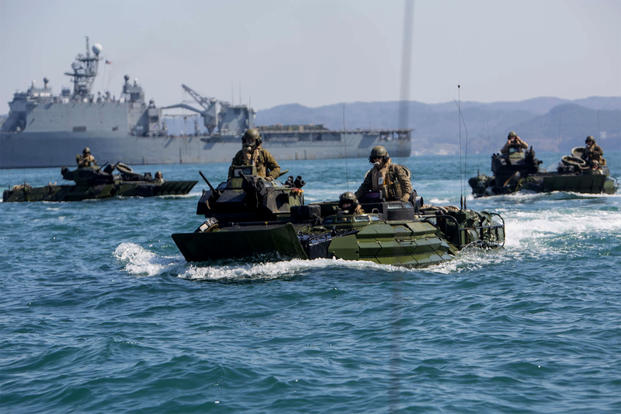A report released by the Government Accountability Office this fall finds the Navy and Marine Corps are falling short in adequate and consistent training for amphibious missions, with stateside units often missing out as next-to-deploy units get precious shipboard training time.
The report does fault the services for not doing enough to maximize virtual training and experimentation, but it also points out that a dearth of available amphibious ships are putting a strain on the force.
The Marine Corps has long maintained it needs a minimum force of 38 amphibious ships to fight missions around the globe, although officials said they could really use 50. Today, there are 32 amphibious ships in the inventory, and 14 are undergoing maintenance and unavailable for missions, Vice Adm. Andrew Lewis, Deputy Chief of Naval Operations for Operations, Plans and Strategy, told a panel of the House Armed Services Committee Friday.
The GAO report, discussed at Friday's hearing, illustrates the effects of the amphibious shipping shortfall. According to the document, a survey of I Marine Expeditionary Force on the West Coast, the Navy could not fulfil 293 out of 314 requests -- 93 percent -- for Navy ship support for training in Fiscal 2016. At II MEF on the East Coast, 19 out of 40 requests were denied.
While the report did not include data for III MEF, forward-deployed in the Pacific, it noted that cuts were being taken to planned amphibious exercises there as well.
"Officials from III MEF told us that the large-scale amphibious exercise Ssang Yong is planned to be conducted every other year, but that the exercise requires the availability and alignment of two [Amphibious Ready Group-Marine Expeditionary Units] in order to have enough forces to conduct the exercise. These officials stated that this alignment may only happen every 3 years, instead of every other year, as planned," the report states.
The exercise, a joint endeavor with the South Korean military, has taken on added significance amid North Korean threats and ballistic missile tests.
Like Lewis, Lt. Gen. Beaudreault, deputy commandant for Plans, Policies and Operations, said he agreed with the GAO's findings.
"The current inventory of 32 amphibious warships is short of our need to satisfy operational requirements, which does negatively impact the naval force's ability to generate readiness and negatively affects availability for training with larger-scale formations," he said.
Beaudreault said the Marine Corps was now focusing on fully preparing next-to-deploy units and working to integrate more experimentation with new concepts into already scheduled exercises. The service recently used the planned exercise Dawn Blitz as a backdrop for a proof-of-concept test in which they fired a High Mobility Artillery Rocket System from an amphibious ship and obliterated a ground target 43 miles away.
"We can't afford to have a set of ships to exercise and another set to experiment," Beaudreault said.
More amphibious ships are on the way for the Marine Corps, but it will take time. Beaudreault said the inventory of amphibs is expected to grow to 34 ships beginning in Fiscal 2021, and grow toward the goal of 38 ships by Fiscal 2033.
-- Hope Hodge Seck can be reached at hope.seck@military.com. Follow her on Twitter at @HopeSeck.













